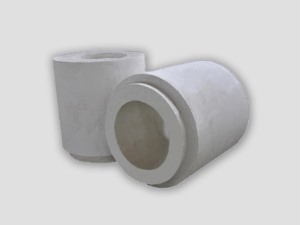Main components of refractory materials such as breathable bricks, nozzle block bricks, castables, etc.
Refractory materials are widely used in metallurgy, chemical technology, petroleum and petrochemical, machinery manufacturing, power processing and other industrial fields, among which the amount is large in the metallurgical industry. In the steel ladle and refining furnace in the steelmaking industry, the refractory materials commonly used by steelmaking manufacturers have air permeability Bricks, nozzle block bricks, electric furnace cover, castables, drainage sand, magnesia-carbon bricks, etc. These refractories are different, and their main components and additives are very different. From a chemical analysis, refractory materials are composed of minerals, such as Corundum, mullite, magnesia, etc., the main components of which are alumina, magnesia, etc.
For the main component of refractory material, it is the matrix component that constitutes the property of refractory, and it is the basis of the characteristics of refractory material, which directly determines the properties of refractory products. For example, breathable bricks need to use high-quality ore, and then go through strict and reasonable processes. The main components of refractory materials can be oxides (alumina and magnesium oxide, etc.), or elements or non-oxide compounds (carbon, silicon carbide, etc.) Wait).
According to the nature of the main components, refractory materials can be divided into three categories: acidic, neutral and basic. Acidic refractory materials are mainly materials containing acidic oxides such as silicon oxide. The main component is silicic acid or aluminum silicate. Salts are formed under the action of high temperature and alkali. The main chemical components of basic refractories are magnesium oxide, calcium oxide, etc. Common refractory products include drainage sand, ladle slides, etc. Neutral refractories are strictly carbon In addition, high alumina refractories (alumina content greater than 45%) are neutral refractories that tend to be acidic, while chrome refractories are alkaline and tend to be neutral refractories. Common High alumina refractory materials include breathable bricks, nozzle block bricks, electric furnace cover, etc.

Previous: Iron hook ramming material and castable for blast furnace
下一条: How to reduce nitrogen content in steel during intermediate frequency induction furnace smelting
Related Industry Knowledge
- Features and Benefits of Coil Clay
- What are the advantages of a good furnace lining
- Misunderstandings in the use of ramming materials in intermediate frequency furnaces
- Phenomenon analysis of failure of argon blowing of ladle permeable bricks and how to improve the rate of argon blowing
- Where is the consumption reduction and energy saving of breathable bricks reflected?
- How to improve the service life of intermediate frequency furnace lining
- Reasons for damage to intermediate frequency furnace lining and how to solve them
- The performance and advantages of breathable brick
- Analysis of Structural Characteristics of Dispersive Breathable Bricks
- The intermediate frequency furnace charge knotting process needs to pay attention to details sharing
- Iron hook ramming material and castable for blast furnace
- What is the difference between stainless steel pipes produced by refining furnaces and intermediate frequency furnaces?
- The performance characteristics of ramming material and its construction introduction
- What role does the coil glue play between the coil turns?
- What are the main performances of breathable bricks
- A brief introduction to the main manifestations of energy saving and consumption reduction of breathable bricks
- What are the performance and advantages of breathable bricks
- Furnace lining manufacturers briefly describe the reasons for the corrosion phenomenon of furnace surface lining
- How to deal with the damage of intermediate frequency furnace lining
- What are the precautions for the use of impermeable breathable bricks?


